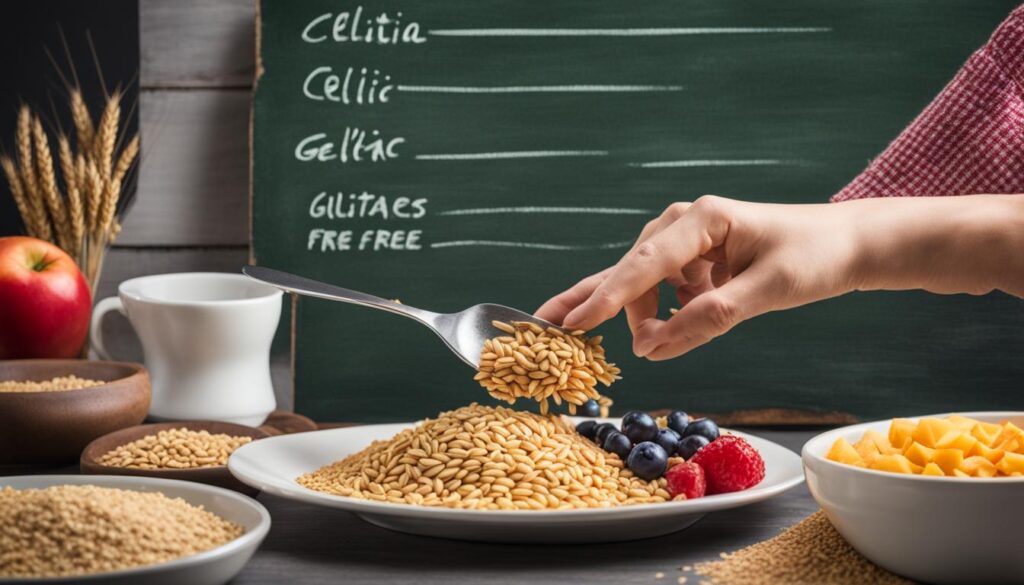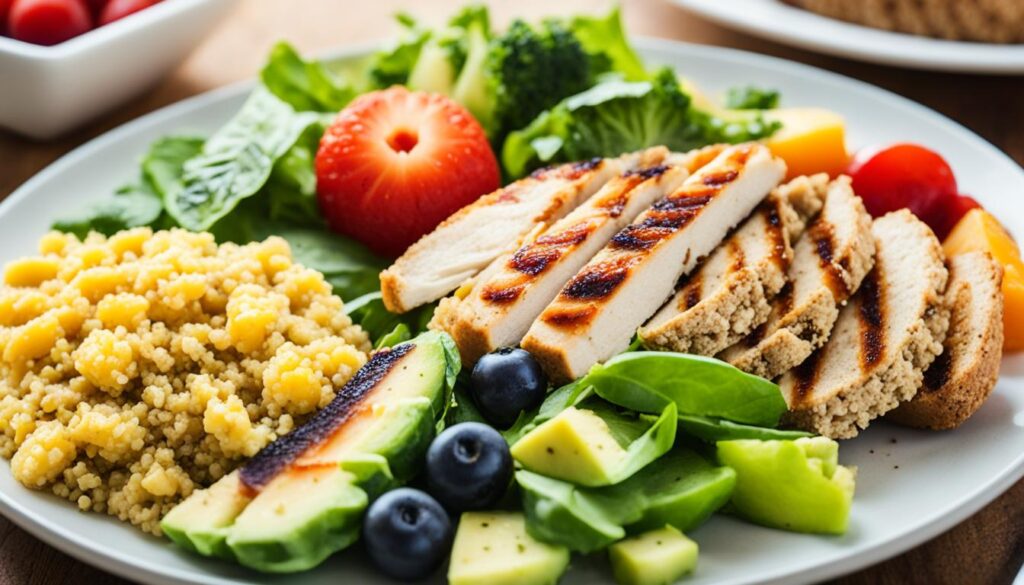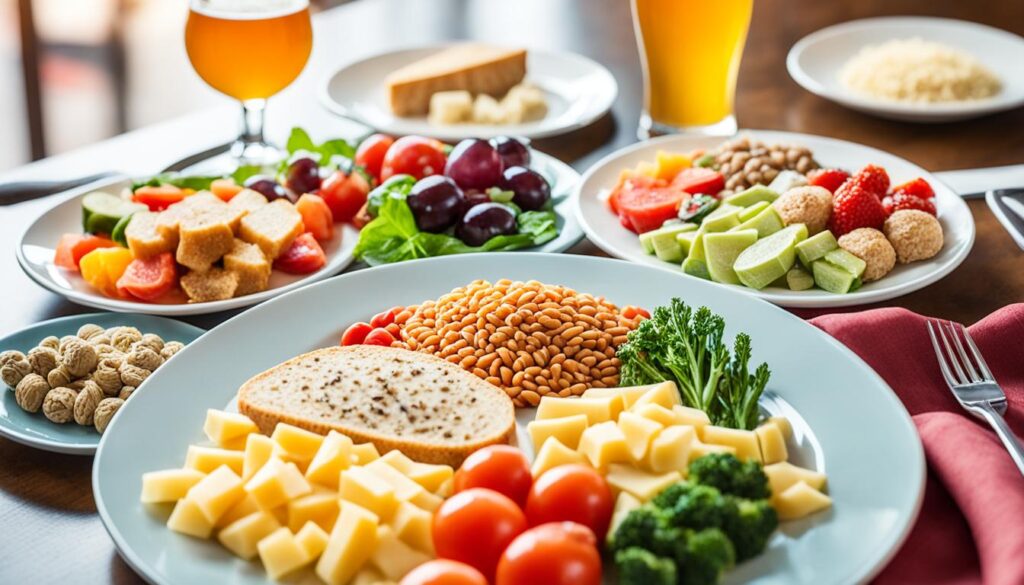Living with celiac disease can present unique challenges, but with the right knowledge and strategies, you can maintain a healthy and fulfilling lifestyle. In this article, we will explore the foods to avoid and provide you with safe eating tips for celiac disease.
Table of Contents
ToggleCeliac disease is an autoimmune disorder that affects the small intestine and is triggered by gluten, a protein found in wheat, barley, and rye. To protect your intestines and prevent further damage, it is vital to eliminate foods that contain gluten from your diet.
Gluten can be lurking in unexpected places, such as sauces, condiments, and processed meats. Therefore, it is crucial to read ingredient labels carefully and choose foods that are certified gluten-free. Opting for naturally gluten-free foods like meat, fish, rice, fruits, and vegetables can help you maintain a well-rounded and nutritious diet.
By following these safe eating tips and being mindful of the foods to avoid, you can effectively manage your celiac disease and enjoy a healthy, gluten-free lifestyle.
Understanding Celiac Disease and Gluten
Celiac disease is a disorder that affects the small intestine and is triggered by an immune reaction to gluten. Gluten is a protein commonly found in wheat, barley, and rye. When individuals with celiac disease consume gluten, their immune system responds by damaging the villi in the small intestine. This immune reaction impairs the absorption of essential nutrients, leading to malnourishment and various health complications. To prevent further damage to the intestines, it is crucial for individuals with celiac disease to strictly avoid gluten in their diet.

The immune reaction triggered by gluten in individuals with celiac disease is a unique characteristic of this disorder. The body mistakenly identifies gluten as a threat and initiates an immune response, damaging the delicate structures in the small intestine. As a result, crucial nutrients, including vitamins and minerals, cannot be adequately absorbed, leading to deficiencies and related health issues.
By understanding the connection between celiac disease and gluten, individuals can take necessary steps to manage their condition effectively. Eliminating gluten from the diet is crucial in minimizing the risk of further damage to the small intestine and promoting overall well-being.
To summarize:
- Celiac disease: A disorder that damages the small intestine, caused by an immune reaction to gluten.
- Gluten: A protein found in wheat, barley, and rye that triggers the immune response in individuals with celiac disease.
- Immune reaction: The body’s response to gluten, damaging the villi in the small intestine and hindering nutrient absorption.
| Celiac Disease | Gluten | Immune Reaction |
|---|---|---|
| A disorder that damages the small intestine | A protein found in wheat, barley, and rye | The body’s response to gluten, damaging the villi in the small intestine and hindering nutrient absorption |
Foods to Avoid on a Gluten-Free Diet
When following a gluten-free diet for celiac disease, it is crucial to avoid foods that contain gluten. Gluten is a protein found in grains such as wheat, barley, and rye. It can cause damage to the small intestine in individuals with celiac disease, leading to various health complications.
To ensure a gluten-free diet, it is important to read labels carefully and be aware of common sources of gluten. Here are some foods to avoid:
| Foods to Avoid |
|---|
| Breads |
| Cereals |
| Pasta |
| Processed foods |
| Sauces and condiments |
| Processed meats |
These foods may contain gluten or be cross-contaminated with gluten during processing. It’s essential to check the ingredient list for any hidden sources of gluten, such as wheat flour, barley malt, or rye extract. Some products may be labeled as “gluten-free,” providing a safer option. If uncertain, it’s always best to consult with a healthcare professional or a registered dietitian.
By avoiding these foods and being diligent about reading labels, individuals with celiac disease can effectively manage their condition and prevent the negative health effects of gluten consumption.

Foods to Enjoy on a Gluten-Free Diet
While following a gluten-free diet for celiac disease, you don’t have to miss out on delicious and nutritious food options. There are plenty of alternatives to wheat-based products that you can enjoy. Here are some gluten-free foods that you can include in your diet:
Fruits and Vegetables
Fresh fruits and vegetables are naturally gluten-free and packed with vitamins, minerals, and fiber. Incorporate a variety of colorful fruits and vegetables into your meals and snacks for a nutritious gluten-free diet.
Meats and Fish
Meat and fish are excellent sources of protein and are naturally gluten-free. Opt for lean cuts of meat and unprocessed fish to enhance your gluten-free meals.
Dairy Products
Dairy products such as milk, cheese, and yogurt are safe to consume on a gluten-free diet. They provide essential nutrients like calcium and vitamin D. Just make sure to check for any added flavors or ingredients that may contain gluten.
Gluten-Free Grains and Flours
There are many gluten-free grains and flours that you can use as alternatives to wheat-based products. Some popular options include:
- Quinoa
- Buckwheat
- Corn
- Amarynth and hemp flour
These gluten-free grains and flours can be used to make delicious bread, pasta, and baked goods that are safe for individuals with celiac disease.
Specialty Gluten-Free Products
In addition to naturally gluten-free foods, there are many specialty gluten-free products available in grocery stores. These products are specifically designed for individuals with celiac disease and allow you to enjoy a wide variety of gluten-free breads, pastas, and baked goods. Just be sure to check the labels for the “gluten-free” certification to ensure they are safe to consume.
Gluten-Free Diet Foods to Enjoy Table:
| Foods to Enjoy | Description |
|---|---|
| Fruits and Vegetables | Naturally gluten-free, packed with vitamins, minerals, and fiber. |
| Meats and Fish | Excellent sources of protein and naturally gluten-free. |
| Dairy Products | Safe to consume on a gluten-free diet, provide essential nutrients like calcium and vitamin D. |
| Gluten-Free Grains and Flours | Alternatives to wheat-based products, including quinoa, buckwheat, corn, and amateur and hemp flour. |
| Specialty Gluten-Free Products | Specifically designed for individuals with celiac disease, allow you to enjoy a wide variety of gluten-free breads, pastas, and baked goods. |
Remember, always check labels and certifications to ensure that foods and products are truly gluten-free and safe for your gluten-free diet. Enjoying a gluten-free diet doesn’t mean sacrificing delicious meals and snacks!
Tips for Following a Gluten-Free Diet
Following a gluten-free diet can be challenging, but with the right tips and strategies, you can successfully manage celiac disease and enjoy a healthy, gluten-free lifestyle. Here are some helpful tips to make the transition easier:
Become Familiar with Hidden Sources of Gluten
It’s important to educate yourself about ingredients and food products that may contain gluten. While obvious sources like wheat, barley, and rye should be avoided, gluten can also be found in unexpected places such as sauces, condiments, and processed meats. Always read ingredient labels carefully and look for gluten-free certifications to ensure you’re making safe choices.
Ask Questions When Dining Out
When eating out, don’t hesitate to ask questions about the menu and preparation methods. Inform the restaurant staff about your dietary restrictions and inquire about gluten-free options. Many restaurants now offer gluten-free menus or can modify dishes to accommodate your needs. Checking online menus before dining out can also help you plan ahead and find suitable options.
Prevent Cross-Contamination in Your Kitchen
To avoid cross-contamination, it’s crucial to separate kitchen items used for preparing gluten and gluten-free foods. Use separate cutting boards, utensils, and appliances, or thoroughly clean them between uses. Keep gluten-free ingredients and products in designated areas to reduce the risk of accidental gluten exposure.
Join Support Groups and Utilize Online Resources
Connecting with others who follow a gluten-free diet can provide valuable support and guidance. Consider joining local support groups or online communities where you can share experiences, ask questions, and exchange recipe ideas. Online resources, such as gluten-free blogs and websites, can offer helpful information and tips for navigating your gluten-free journey.
By following these tips, you can successfully manage celiac disease and embrace a gluten-free lifestyle. Remember, while the initial adjustment may feel challenging, with time and practice, it will become second nature. Stay informed, stay connected, and enjoy a wide variety of delicious gluten-free foods.
Eating Out on a Gluten-Free Diet
Following a gluten-free diet can sometimes make eating out a challenge, but with a little planning and communication, you can still enjoy dining out while staying true to your dietary needs. Here are some tips to help you navigate restaurant menus and find gluten-free options:
Inform the restaurant staff
When you arrive at the restaurant, let the staff know about your dietary restrictions. Explain that you need to avoid gluten due to celiac disease. This will help them understand your needs and make appropriate accommodations.
Inquire about gluten-free options
Ask the staff if they have a separate gluten-free menu or if they can modify existing dishes to make them gluten-free. Many restaurants now offer gluten-free options or are willing to adapt their menu items to accommodate customers with dietary restrictions.
Review menus online
Prior to visiting a restaurant, check their menu online. This will give you an idea of the available options and help you determine if they have suitable gluten-free choices. Some restaurants even indicate which dishes are gluten-free on their website.
Bring your own gluten-free condiments
To ensure that you avoid hidden sources of gluten, consider bringing your own gluten-free condiments or dressings from home. This way, you can enhance the flavor of your meal without worrying about accidentally consuming gluten.
Remember, communication is key when dining out on a gluten-free diet. By informing the restaurant staff about your needs and asking questions about gluten-free options, you can enjoy a safe and delicious meal while managing your celiac disease.

Conclusion
Managing celiac disease is a lifelong commitment that requires strict adherence to a gluten-free diet. By diligently avoiding foods that contain gluten and remaining mindful of hidden sources of gluten, individuals with celiac disease can effectively manage their condition and lead a healthy and fulfilling life.
Adjusting to a gluten-free lifestyle may initially seem challenging, but with time and effort, it becomes easier to navigate through daily dietary choices. The support of resources and communities dedicated to celiac disease management can play a crucial role in providing guidance, useful tips, and recipe ideas to make the transition smoother.
Remember, although living with celiac disease can be demanding, it is possible to enjoy a wide variety of delicious gluten-free foods. Educate yourself about safe ingredients, experiment with alternative grains and flours, and discover a new world of flavors and culinary possibilities. Through dedication and the support of others, you can successfully manage your celiac disease and embrace a fulfilling gluten-free lifestyle.
FAQ
What is celiac disease?
Celiac disease is an autoimmune disorder that damages the small intestine and prevents the absorption of nutrients. The immune system reacts to gluten, a protein found in wheat, barley, and rye, causing damage to the villi in the small intestine.
What is gluten?
Gluten is a protein found in wheat, barley, and rye. When a person with celiac disease consumes gluten, their immune system reacts by damaging the villi in the small intestine, preventing nutrient absorption.
What foods should be avoided on a gluten-free diet?
Foods that contain gluten should be avoided on a gluten-free diet. This includes grains such as wheat, barley, and rye, as well as products made with these grains.
What foods can be enjoyed on a gluten-free diet?
Fruits, vegetables, meats, fish, and dairy products are all naturally gluten-free and can be included in a well-balanced gluten-free diet. There are also gluten-free grain and flour alternatives available, such as quinoa, buckwheat, and corn.
What tips can help with following a gluten-free diet?
Tips for following a gluten-free diet include becoming familiar with hidden sources of gluten, reading ingredient labels carefully, separating kitchen items used for gluten and gluten-free foods, and seeking guidance and recipes from support groups or online resources.
How can I eat out on a gluten-free diet?
When eating out on a gluten-free diet, it is important to inform restaurant staff about your dietary restrictions, inquire about gluten-free options on the menu, and review menus online before dining out. Bringing gluten-free condiments from home can also be helpful.
How can celiac disease be managed?
Managing celiac disease involves strict adherence to a gluten-free diet. Avoiding foods that contain gluten and being mindful of hidden sources of gluten are key to successfully managing the condition and maintaining a healthy lifestyle.


